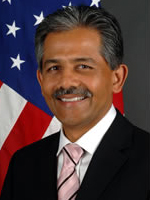
Any horse racing or baseball fan will tell you spring means it’s time to compete. So will a recent blossoming of reports and initiatives focused on competitiveness itself.
Early this month, senior officials from the U.S. Department of Commerce’s International Trade Administration (ITA) and Economic Development Administration (EDA) led a 45-member international delegation from 20 Latin American and Caribbean countries in the inaugural Americas Competitiveness Exchange on Innovation and Entrepreneurship, visiting hubs of innovation in Atlanta; Greenville, S.C.; and several communities in the Charlotte region of North Carolina. ITA is partnering with EDA, the U.S. Department of State, and the Organization of American States (OAS) to meet the Department of Commerce’s priority of increasing competitiveness both domestically and in the Americas region under the US-Mexico High Level Economic Dialogue and the Inter American Competitiveness Network.
Tom Guevara, EDA deputy assistant secretary for regional affairs, and Ambassador Vinai Thummalapally, the new executive director for SelectUSA, found time to talk with Site Selection after a reception in Atlanta (where the above photo was taken), the city that hosted the inaugural Americas Competitiveness Forum in 2007 (this year’s will be in October in Port of Spain, Trinidad & Tobago). When asked about reactions to the first SelectUSA Summit held last fall in the nation’s capital, they echoed comments made a few minutes earlier to the delegation by Congressmen Filemon Vela and Beto O’Rourke of Texas, members of the congressional border caucus representing the Brownsville and El Paso areas, respectively, and by Walter Bastian, the DOC’s deputy assistant secretary of commerce for the Western Hemisphere. Namely: Sometimes government agencies such as EDA, SelectUSA and DOC really do help get things done.
Thummalapally said many were frankly surprised SelectUSA could pull it off, especially in getting the President of the United States and five of his secretaries to show up. During talks in Japan with officials at JETRO, the organization charged with attracting corporate investment to Japan, Thummalapally was asked how he made it happen and how JETRO could do something similar. Thummalapally, a trained mechanical engineer who once served as president of optical disc company MAM-A Inc., and Guevara agreed that one of the things government does best is simply convene.
“There are a lot of Toms and Walters out there who want to make a difference,” said Thummalapally of his colleagues. “They want companies to succeed, they want entrepreneurs to find like-minded people doing similar work. In electronics we called it resonance — two frequencies meet and the result is exponential. In some instances, it’s not ‘two plus two equals four’ — it could be infinity. We’re not sure where the next Sergey Brin is coming from — it could be Belize, Costa Rica, or right here in Atlanta.”
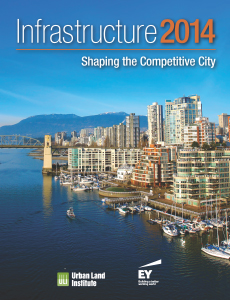
One of SelectUSA’s purposes is to serve as ombudsman for foreign companies looking to invest in the United States. The SelectUSA chief cites a current case highlighting how the notoriously glacial pace of government can be prodded now and then, in part because of the all hands on deck FDI mission broadcast at last fall’s summit.
“I’m working on an advocacy case right now,” said Thummalapally. “We’ve been working with this particular investment opportunity between one of our states in the South, and one location in Latin America. These two companies need to co-locate in one of these two locations. We first heard about it one week ago. On Thursday, we had a conversation with two key decision-makers. On Friday both ambassadors reached out. And on Saturday I got a call from EDA saying up the game, and asking me to reach out to [US Commerce Secretary] Penny Pritzker to make the call. I was told there was pushback because of her heavy schedule. I said it was not acceptable. I called her chief of staff, and within two hours Penny was prepared to make the calls she has to make. One call was made this morning, and one will happen within the next 24 hours.
“It’s not about how we won and they lost,” he said. “We believe this is good for those companies because of the cost of energy, and ultimately good for their countries — and for the country we’re competing against.”
Among other projects, Sec. Pritzker announced this month that SelectUSA had helped Lufthansa Technik in its decision to break ground on a new aviation maintenance, repair and overhaul facility in Puerto Rico to service short- and medium-haul aircraft. With the support of Vice President Joe Biden, the White House National Economic Council, and the President’s Task Force on Puerto Rico, the SelectUSA team worked with the Puerto Rico team and Puerto Rico Gov. García Padilla to offer Lufthansa information and assistance from across federal agencies and departments.
FDI in the United States and its territories rose from $160.6 billion in 2012 to $187.5 billion in 2013.
Measuring the Cost
But the US still has a ways to go. Also this month, KPMG issued its annual “Competitive Alternatives” report, using seven business-to-business (B2B) service sector operations and 12 different manufacturing sector operations to compare 26 business costs in more than 100 cities in 10 countries: Australia, Canada, France, Germany, Italy, Japan, Mexico, the Netherlands, the United Kingdom and the United States. For 2014, Competitive Alternatives further expanded its coverage in the US, and for the first time includes every US metro area with a population of 2 million or more. The four largest US metro areas — New York City, Los Angeles, Chicago, and Dallas-Fort Worth — form the US baseline against which costs for major cities in other countries are compared to determine the national results. Two major cities are used to calculate the national results for each country, with the exceptions of the baseline US and the Netherlands, where KPMG used two mid-sized cities rather than big cities such as Amsterdam and Rotterdam, stating that costs are so homogenous across the country that it made no difference. Asked about this, KPMG Principal Hartley Powell and Ulrich Schmidt, managing director, global location & expansion services for KPMG, replied by email:
“While facility costs represent the one cost area where some variation appears between larger and mid-sized Netherlands cities, even here differences are small compared to the large differences seen between primary and secondary cities in (for example) the UK, France, US and Japan. For example, in 2012 we included Amsterdam and Rotterdam in the study, and the Netherlands still ranked first among the mature market countries for low suburban office lease costs and a very-close second among the mature market countries for downtown office lease costs.”
The report also looks at non-cost competitiveness factors.
“Mexico, the lowest-cost country examined, is the only high-growth (emerging) country included in the study. As a NAFTA member, Mexico’s 18.7-percent cost advantage over the United States in 2014 is similar to 2010,” says the report. “With little change in the value of the Mexican peso over that four-year period, Mexico’s cost advantage relative to its northern neighbor has been holding steady.
“Canada ranks second among the 10 countries, with business costs 7.2 percent lower than in the United States. Moving ahead of both the Netherlands and the United Kingdom, Canada re-establishes a competitive advantage over these countries seen in 2010 and earlier editions of Competitive Alternatives. Costs in the Netherlands (third) and the United Kingdom (fourth) are similar, at 5.5 and 5.4 percent (respectively) below the US baseline — essentially unchanged from 2012. Among the countries studied, only Germany has business costs higher than those in the United States.”
“The most dramatic change in the international cost competitiveness rankings in 2014 is a big gain for Japan,” says the report, which ranks seventh among the 10 nations, and ahead of the 9th-place US for the first time since Japan was included in the study in 1999. “Years of low inflation allowed Japan to gradually improve its competitive position during the 2000s, even as the yen appreciated,” says the report. “Now, with a significant drop in the value of the yen over the last two years, we are witnessing a new paradigm in Japan’s global cost competitiveness.”
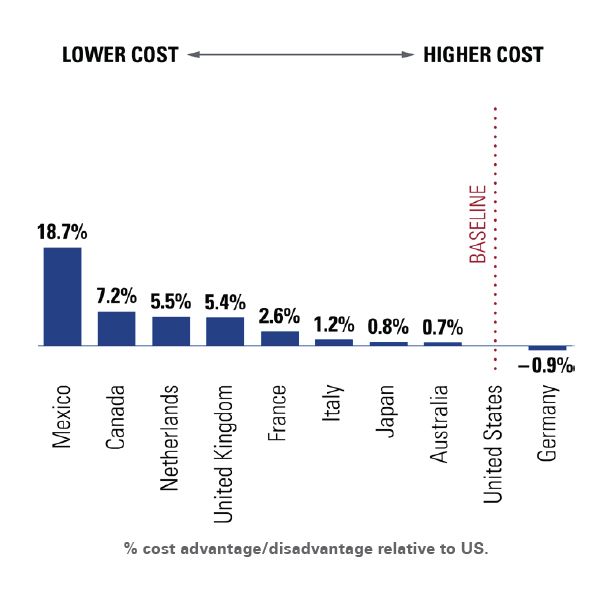
Broken out by specific subsectors, the cost rankings look like this:
Digital Services (software development, video game studio)
- Mexico (28.7-percent cost advantage over the US baseline)
- Canada (17.8%)
- UK (10.4%)
R&D (biomed lab, electronics testing, clinical trial)
- Mexico (36.6%)
- Netherlands (16.3%)
- Canada (15.8%
Corporate Services (shared services, financial services)
- Mexico (46%)
- UK (12.7%)
- Canada (12.5%)
Within North America, the range of cities examined by KPMG includes at least one city from each of the 50 US states and the 10 Canadian provinces, plus two major cities in Mexico. US MSA rankings by cost index appear below, topped by Atlanta, Cincinnati, Orlando, Charlotte and San Antonio.
However, when all the world cities evaluated by KPMG are viewed as a group, some might be surprised to find metro areas such as Vancouver and Toronto more affordable than such historically affordable MSAs as Kansas City, Cleveland and St. Louis. To what factors do they attribute the top city rankings of the Canadian cities (see infographic below) over all US cities?
“Tax reforms over the last decade have played a significant role in the improved competitiveness of the Canadian cities,” say Powell and Schmidt of KPMG. “The federal corporate income tax rate in Canada is now just 15 percent, and the typical provincial rate is about 10 percent for a total tax rate of approximately 25 percent — which is generally below the US federal corporate tax rate. Machinery and equipment are not subject to property tax. And in most instances sales taxes are GST, leaving companies with a negligible net sales tax cost after allowing for rebates for tax paid. Significantly lower employer-paid benefit costs also represent an advantage for the Canadian cities — averaging 26 percent of payroll versus 36 percent in the US, which can be attributed to, among other things, the cost of private medical insurance faced by US employers.”
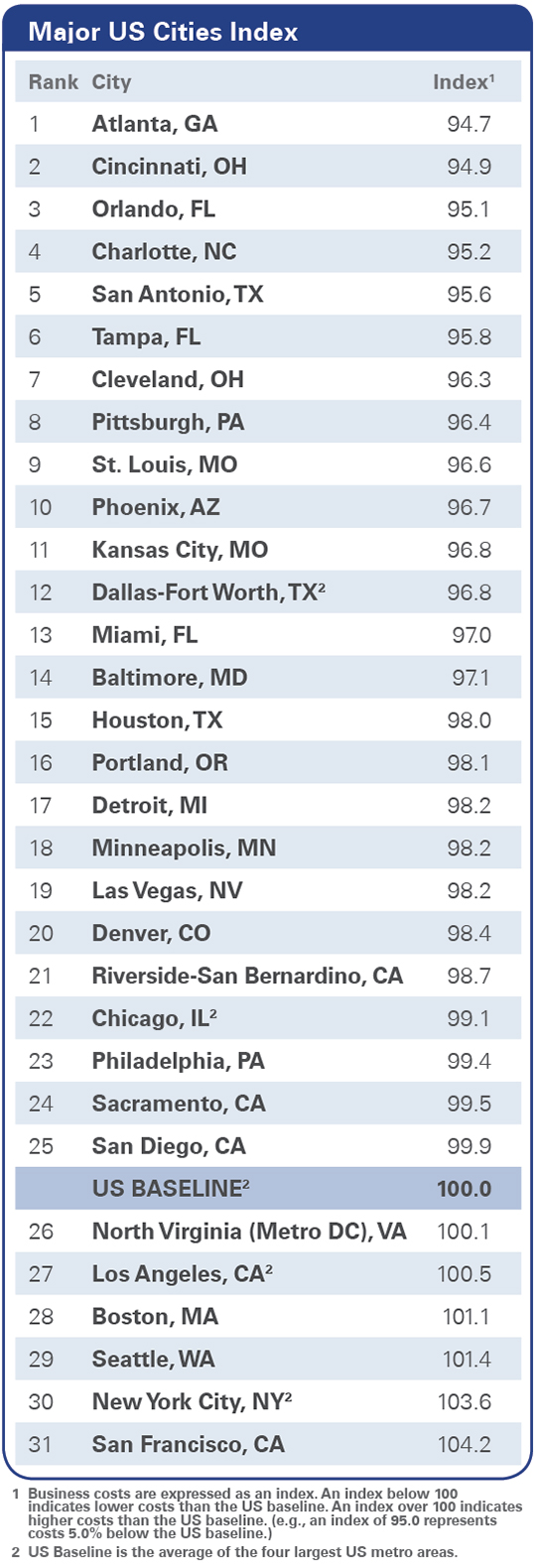
KPMG acknowledged that Mexico was the only emerging market to appear in the study, but, said Luis Ricardo Rodriguez of the consultancy’s global location & expansion services division in Mexico, “its economic stability, low wages, reforms in important sectors, and active pursuit of trade agreements globally continue to attract the attention of international investors,” and hence warranted its inclusion in the study. Asked about the country’s non-cost factors, KPMG’s Powell and Schmidt replied:
“With respect to Mexico’s non-cost competitiveness factors, one area we see improvement in relates to the quality of its infrastructure. Between the 2012 and 2014 editions of Competitive Alternatives, Mexico saw its score improve on both measures we use in this area – i.e., ICT infrastructure and distribution infrastructure (page 54, 2014 edition). Mexico’s scores also improved between our 2012 and 2014 editions of Competitive Alternatives for the measures we report related to commercial real estate transparency and market access (page 51, 2014 edition) and employer flexibility under employment legislation (page 49, 2014 edition). So Mexico seems to be moving in the right direction in a number of important non-cost areas.”
The Transit Key
As luck would have it, KPMG’s fellow consultancy Ernst & Young, along with the Urban Land Institute, on April 9 released its annual infrastructure report titled “Infrastructure 2014: Shaping the Competitive City.” There’s that C word again.
The report was released at ULI’s 2014 Spring Meeting in Vancouver, BC, a city known for rising costs but that somehow placed fifth in KPMG’s cost study among all North American cities with populations over 2 million, even cheaper than places like Pittsburgh, Tampa and Cincinnati. As it happens, Vancouver and other Canadian cities top a separately release report on city resiliency from developer Grosvenor.
The EY/ULI survey, conducted in January 2014, reflects the opinions of 241 public-sector officials and 202 senior-level real estate executives (developers, investors, lenders and advisors) based in large and mid-sized cities across the globe, with concentrations in the United States, Europe and Asia Pacific.
“Among the combined group of public and private sector participants, 88 percent rated infrastructure quality as the top influencer of real estate investment and development,” said a release. “Demographic forces, including consumer demand and workforce skills, ranked as other top considerations determining real estate investment locations. Infrastructure quality was rated as the highest influencer by public leaders (91 percent) and second to highest by private leaders (86 percent). Consumer demand was viewed as the top factor by the private sector (90 percent).
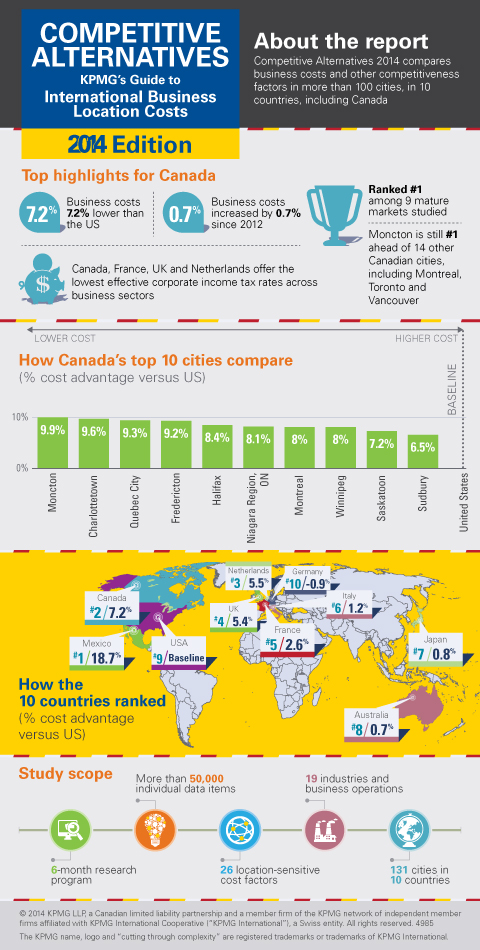
Strong telecommunications systems (including high-speed internet capability) led the list of infrastructure categories that drive real estate investment, along with good roads, bridges, and reliable and affordable energy.
Among the survey’s key findings:
- Public transit led the list of infrastructure investment priorities. Seventy-eight percent of survey respondents’ said public transit systems, including bus and rail, should receive top priority for infrastructure improvements, followed by roads and bridges (71 percent) and pedestrian facilities (63 percent).
- Investment priority rankings tended to be the inverse of quality perceptions, with only 48 percent of survey respondents ranking public transit as “good” or “very good” in quality, and 51 percent saying sidewalks and pedestrian facilities were good or very good.
- Roads and bridges received modest quality marks, with 60 percent of respondents rating them good or very good. (By contrast, 90 percent of respondents said health care facilities were good or very good, placing these facilities at the top of the quality list.)
The public’s willingness to pay for infrastructure was ranked as the top factor shaping both infrastructure and real estate development over the next 10 years, followed by consumer demand for compact, walkable development, and the prevalence of families with children. The cost and availability of energy and the use of innovative pricing systems to fund, manage, and operate infrastructure ranked slightly lower.
The report also includes three case studies of infrastructure investments that have catalyzed economic growth:
- London’s Olympic Park, cited as an example of building infrastructure for permanence. “The infrastructure built for the Olympic Games in London was designed to benefit the surrounding neighborhoods for decades to come. As a result, areas near the site have experienced more multifamily housing development than nearly anywhere else in the U.K.”
- The Biscayne Bay Tunnel Project in Miami, an example of a strategic investment in port connections. “The city is expanding access to its port through a public-private partnership that is building tunnels to link the main Interstate directly to the port. The improved truck access is aimed at reducing congestion on downtown surface streets and boosting the competitiveness of the port in anticipation of the Panama Canal expansion.”
- The Hong Kong transit system, designed specifically to link real estate and transit. Planning and designing the system around this linkage, along with the development of land around transit stations, has resulted in superior transit service, compact land use patterns throughout Hong Kong and profitability for the system.

